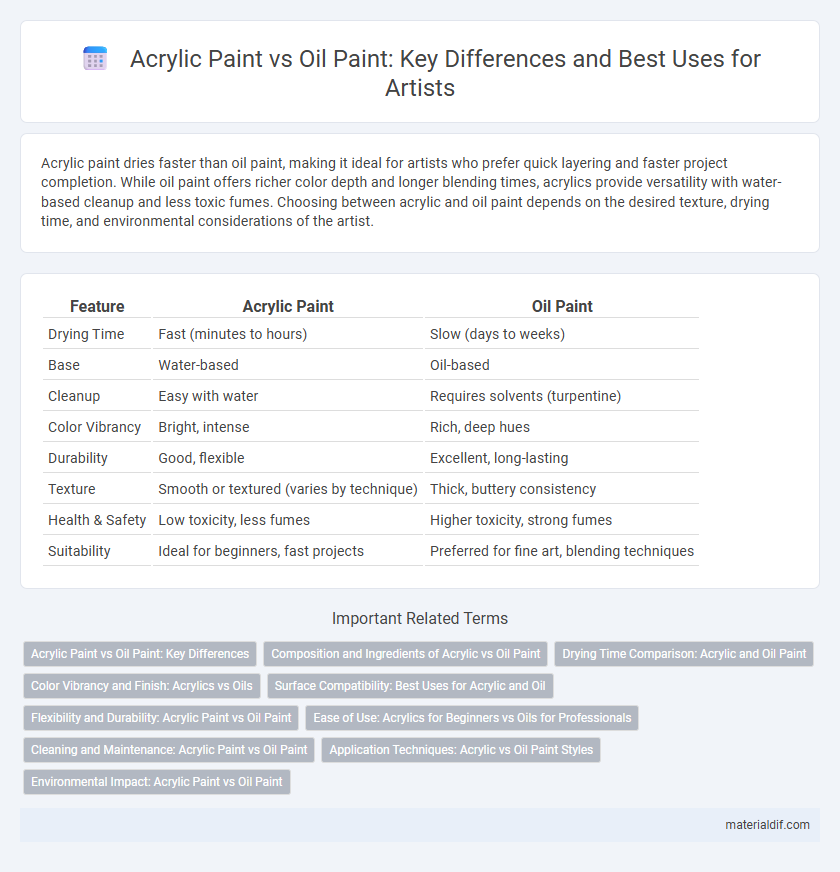Acrylic paint dries faster than oil paint, making it ideal for artists who prefer quick layering and faster project completion. While oil paint offers richer color depth and longer blending times, acrylics provide versatility with water-based cleanup and less toxic fumes. Choosing between acrylic and oil paint depends on the desired texture, drying time, and environmental considerations of the artist.
Table of Comparison
| Feature | Acrylic Paint | Oil Paint |
|---|---|---|
| Drying Time | Fast (minutes to hours) | Slow (days to weeks) |
| Base | Water-based | Oil-based |
| Cleanup | Easy with water | Requires solvents (turpentine) |
| Color Vibrancy | Bright, intense | Rich, deep hues |
| Durability | Good, flexible | Excellent, long-lasting |
| Texture | Smooth or textured (varies by technique) | Thick, buttery consistency |
| Health & Safety | Low toxicity, less fumes | Higher toxicity, strong fumes |
| Suitability | Ideal for beginners, fast projects | Preferred for fine art, blending techniques |
Acrylic Paint vs Oil Paint: Key Differences
Acrylic paint dries significantly faster than oil paint, enabling quicker layering and faster project completion times. Acrylics are water-based, which makes them easier to clean and less toxic compared to oil paints that require solvents like turpentine for thinning and cleaning. The color retention of acrylic paint remains stable over time, whereas oil paint may darken or yellow due to oxidation and varnish aging.
Composition and Ingredients of Acrylic vs Oil Paint
Acrylic paint consists primarily of pigment suspended in an acrylic polymer emulsion, which allows it to dry quickly and be water-soluble when wet. Oil paint is made by mixing pigments with drying oils such as linseed oil, resulting in a slower drying time and a richer, more flexible finish. The synthetic nature of acrylic binders contrasts with the natural oil base of oil paints, influencing texture, drying rates, and durability.
Drying Time Comparison: Acrylic and Oil Paint
Acrylic paint dries significantly faster than oil paint, with acrylics typically drying within 15 to 30 minutes, whereas oil paints can take several days to weeks to fully dry. The rapid drying time of acrylic paint allows for quicker layering and adjustments during the painting process. Oil paint's slower drying time provides extended blending opportunities but requires more time and patience to complete artworks.
Color Vibrancy and Finish: Acrylics vs Oils
Acrylic paint offers brighter and more vibrant colors due to its fast drying time and water-based composition, which helps pigments retain their intensity. Oil paint provides a richer, more luminous finish with deeper color blending capabilities because of its slow drying process and oil-based medium. While acrylics dry to a matte or satin finish, oils typically yield a glossy surface that enhances color depth and texture.
Surface Compatibility: Best Uses for Acrylic and Oil
Acrylic paint adheres well to a wide range of surfaces including canvas, wood, paper, and fabric due to its flexible and fast-drying properties. Oil paint requires primed surfaces like canvas, wood panels, or specially prepared boards to prevent oil absorption and ensure durability. Acrylic is ideal for mixed media and experimental textures, while oil is preferred for traditional techniques on primed surfaces.
Flexibility and Durability: Acrylic Paint vs Oil Paint
Acrylic paint offers superior flexibility due to its polymer-based composition, allowing it to expand and contract with environmental changes without cracking. In contrast, oil paint, derived from linseed oil, tends to become brittle over time, making it more prone to cracking under stress or temperature fluctuations. Durability-wise, acrylic paint resists yellowing and remains stable in humid conditions, whereas oil paint may yellow and deteriorate without proper varnishing and maintenance.
Ease of Use: Acrylics for Beginners vs Oils for Professionals
Acrylic paint dries rapidly, allowing beginners to layer and correct mistakes quickly without long waiting times, making it ideal for novice artists. Oil paint, with its slow drying time, offers professionals extended blending capabilities and richer textures, demanding advanced skills and patience. Mastery of oils often requires more experience due to their complex handling and longer curing process.
Cleaning and Maintenance: Acrylic Paint vs Oil Paint
Acrylic paint requires water for cleaning brushes and tools, making maintenance quick and convenient, whereas oil paint demands solvents like turpentine or mineral spirits, which can be toxic and require proper ventilation. Acrylic dries faster, reducing the chance of smudging during cleanup, while oil paint's slow drying time allows extended working periods but complicates immediate cleaning. Proper maintenance of oil paints involves thorough solvent cleaning and conditioning of brushes with specialized cleaners to prevent damage, unlike acrylics, which clean easily with soap and water.
Application Techniques: Acrylic vs Oil Paint Styles
Acrylic paint dries quickly, allowing artists to layer colors rapidly and experiment with glazing, impasto, and textural effects that create vibrant, fast-drying artworks. Oil paint, with its slow drying time, enables smooth blending, wet-on-wet techniques, and subtle gradations, ideal for achieving realistic textures and rich color depth. These distinct application techniques influence the style and finish of paintings, with acrylics favoring bold, dynamic visuals and oils offering nuanced, detailed compositions.
Environmental Impact: Acrylic Paint vs Oil Paint
Acrylic paint, made from synthetic polymers, generally has a lower environmental impact due to its water-based formulation, which reduces the emission of volatile organic compounds (VOCs) compared to oil paint. Oil paint relies on organic solvents like turpentine and linseed oil, which release higher levels of VOCs harmful to air quality and human health. Disposal and cleanup of acrylic paint are easier and less toxic, whereas oil paint requires hazardous solvent use, increasing environmental risk.
Acrylic Paint vs Oil Paint Infographic

 materialdif.com
materialdif.com